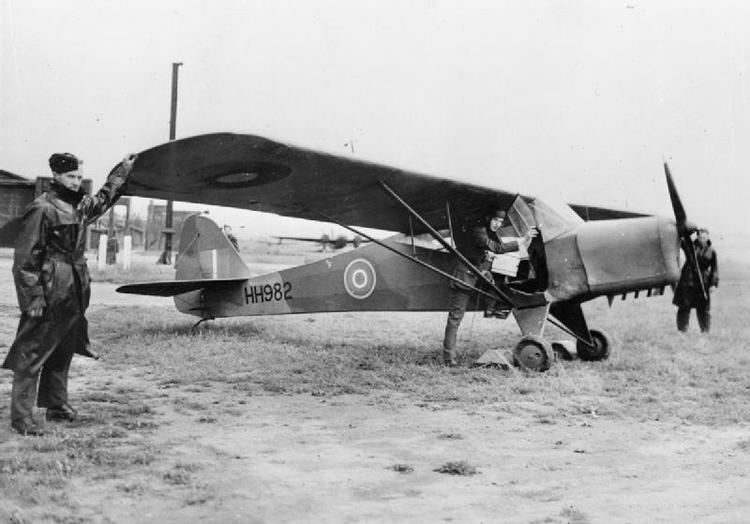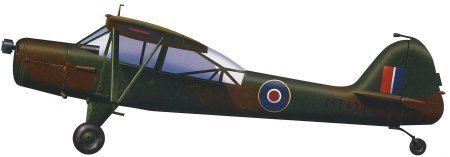Top speed 209 km/h Introduced 1942 | Length 6.83 m | |
 | ||
Taylorcraft auster mki rc model
The Taylorcraft Auster was a British military liaison and observation aircraft produced by the Taylorcraft Aeroplanes (England) Limited company during the Second World War.
Contents
- Taylorcraft auster mki rc model
- Taylorcraft auster mkv
- Design and development
- Operational history
- Variants
- Military operators
- Specifications Auster V
- In popular fiction
- References

Taylorcraft auster mkv
Design and development

The Auster was a twice-removed development of an American Taylorcraft design of civilian aircraft, the Model A. The Model A had to be redesigned in Britain to meet more stringent Civil Aviation standards and was named the Taylorcraft Plus C. After the start of the Second World War, the company developed the model further as an Air Observation Post (AOP)—flown by officers of the Royal Artillery and used for directing artillery fire of British Army Royal Artillery units.

The Plus C was re-engined with the Blackburn Cirrus Minor I engine and redesignated the Taylorcraft Plus D. Most of the civil Plus Cs and Ds were impressed into Royal Air Force service, the Plus Cs were re-engined with the Cirrus Minor I and redesignated as Plus C2.

Prewar tests identified the Taylorcraft Model D as the most suitable aircraft for the AOP role. Three more Ds were purchased from Taylorcraft and a trials unit, D Flight, under Major Charles Bazeley RA, formed at Old Sarum on 1 February 1940. The flight with three Austers and one Stinson Voyager, and three artillery and one RAF pilots, moved to France where they trained with artillery and practised fighter avoidance with Hurricanes of Air Component before moving south to train with French artillery. The flight did not participate in the fighting and withdrew without loss to the UK. However, the War Office then ordered 100 Stinson L-1 Vigilants. Formation of the RAF's Army Cooperation Command in December 1940 led to the RAF rejecting the very notion of light AOP aircraft.

Intercession by General Alan Brooke led to an accommodation that led to the first AOP pilot course for artillery officers taking place in October 1940 and in 1941, the first AOP squadron, No 651, formed. Stinson Vigilants eventually arrived in early 1942 but most had been severely damaged in transit leading to the adoption of the Taylorcraft Auster 1 and an order for 100 aircraft placed. Some of the Stinsons were resurrected but found to be too big for the AOP role.

The Auster II was a re-engined aircraft with an American 130 hp (97 kW) Lycoming O-290 engine. Due to the shortage of American engines that version was not built but led to the Auster III (Model E), which was the same as the Auster I but had a 130 hp (97 kW) de Havilland Gipsy Major engine. The next development was the Auster IV (Model G) which had a slightly larger cabin with three seats and used the Lycoming O-290. The major production version was the Auster V (Model J) which was an Auster IV with blind flying instruments, and a flap modification.
Post war, the Auster Mark V was used as the basis for the Auster J/1 Autocrat intended for the civilian market; the British firm having changed their name to Auster and stopped licensing from Taylorcraft. Further military aircraft were supplied post war; the Auster AOP6, Auster T7 (a trainer), and the Auster AOP9.
Operational history
The Auster Mark III, IV and V were issued to 12 Royal Air Force (RAF), one Polish and three Royal Canadian Air Force (RCAF) Air Observation Post (AOP) Squadrons. The first to deploy was No. 651 Squadron RAF. The leading elements landed in Algiers on 12 November 1942 with eight aircraft, 11 Royal Artillery (RA) pilots, 39 RA soldiers and 25 airmen (mostly maintenance technicians). The normal strength of an AOP squadron was 12 aircraft, 19 RA officers (all pilots), 83 RA other ranks and 63 RAF including two administrative officers. Aircraft were fitted with the Army's No 22 Wireless, an HF set providing two-way voice communications with artillery units and formations on the ground.
On 31 March 1943 the Army Cooperation Command was disbanded, most of its assets being used to form the Second Tactical Air Force.
Four squadrons (No. 651, No. 654 Squadron RAF, No. 655 Squadron RAF and No. 657 Squadron RAF) fought in North Africa and Italy, being joined from August 1944 by No. 663 Polish squadron. The other seven squadrons (Nos. 652, 653, 658, 659, 660, 661 and 662 of the RAF) operated after D-Day in France, the Low Countries and into Germany.
No. 664 Squadron RCAF, No. 665 Squadron RCAF, and No. 666 Squadron RCAF were also issued with the Auster Mk. IV and V, formed in the UK at RAF Andover in late 1944 and early 1945. The RCAF squadrons were manned by Canadian personnel of the Royal Canadian Artillery and the RCAF, with brief secondment to the squadrons with pilots from the Royal Artillery; overall control was maintained in the UK by 70 Group, RAF Fighter Command. The three squadrons deployed from RAF Andover, England, to the Netherlands, to Dunkirk, France, where the last Canadian 'shots' in Europe were fired, and later to occupied Germany.
No. 656 Squadron RAF was assigned to 14th Army and used Austers in Burma, generally with flights assigned to each corps. In European theatres a squadron was generally assigned to each corps, but under command for technical matters of an RAF group.
The Royal Australian Air Force's No. 16 AOP Flight and No. 17 AOP Flight operated Auster Mark III aircraft in support of the Australian Army in the Pacific Theatre from October 1944 until the end of the war.
Postwar Auster AOP aircraft were reorganised into independent flights (probably because the RAF used Wing-Commanders, equivalent to Lieutenant-Colonels, to command squadrons while the army insisted on a major's command) including 1903 Flight in Korea that had artillery pilots from several Commonwealth countries. There was also an Auster-equipped Liaison Flight, No 1913, in that theatre. Air OP flights also operated in the Malayan Emergency. Several AOP squadrons were reformed within the Royal Auxiliary Air Force in 1949 and these operated some AOP.5s, AOP.6s and AOP.9s until at least March 1957, when the Auxiliary Air Force was disbanded. All Auster AOP units were transferred to the Army Air Corps when it was formed in September 1957, with AAC squadrons using numbers starting with 651.
The air observation duties, counter-insurgency and casualty evacuation roles performed by Auster and similar light aircraft were generally taken over by light helicopters from the mid-1960s.
Variants
Military operators
Specifications (Auster V)
Data from British Warplanes of World War II and British Aircraft of World War II.
General characteristics
Performance
Armament
none
In popular fiction
The slow-flying capabilities of the Auster are featured in Nevil Shute's 1958 novel The Rainbow and the Rose.
